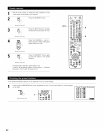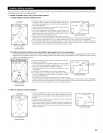
Here we describe a number of speaker settings for different purposes. Use these examples as guides to set up your system according to the type
of speakers used and the main usage purpose.
1. DTS+ES compatible system (using surround back speakers)
(1) Basic setting for primarily watching movies
[] []
Surround backspeakers
{1 spkr or 2 spkrs)
As seen from above
• Set the front speakers with their front surfaces as flush with the TV
or monitor screen as possible Set the center speaker between the
front left and right speakers and no further from the listening position
than the front speakers
• Consuk the owner's manual for your subwoofer for advice on placing
the subwoofer within the listening room
• If the surround speakers are direct+radiating (monopolar) then place
them slightly behind and at an angle to the listening position and
parallel to the walls at a position 60 to 90 centimeters (2 to 3 feet)
above ear level at the prime listening position As seenfrom the side
• When using two sunound back speakers, place them at the back
facing the front at a narrower distance than the front left and right speakers When using one surround back speaker,
place it at the rear center facing the front at a slightly higher position (0 to 20 cm) than the surround speakers
• We recommend installing the surround back speaker(s) at a slightly downward facing angle This effectively prevents
the surround back channel signals from reflecting off the monitor or screen at the front center, resulting in inter[erence
and making the sense of movement from the front to the back less sharp
Surroundspeaker
\
Pointslightly
Frontspeaker downwatds
\
60to90 cm
(2) Setting for primarily watching movies using diffusion type speakers for the surround speakers
For the greatest sense of surround sound envelopment, diffuse radiation speakers such as bipolar types, or dipolar types, provide a wider
dispersion than is possible to obtain from a direct radiating speaker (monopolar). Place these speakers at either side of the prime listening
position, mounted above ear level.
PathOfthe su;'roundsoundfrom the
speakerstothe listening position
Surround back speakers
(1 spkr or 2 spkrs)
AS seen from above
• Set the front speakers, center speaker and subwoofer in the same
positions as in example (1) Surround speaker Surround back
• It is best to place the surround speakers directly at the side or slightly Pointslightly
to the front of the viewing position, and 60 to 90 cm above the ears downwards
• Same as surround back speaker installation method (1)
Using dipolar speakers for the surround back speakers as well is
more effective
• Connect the surround speakers to the surround speaker jacks
• The signals from the surround channels reflect off the walls as
shown on the diagram at the left, creating an enveloping and realistic Asseenfrom the side
surround sound presentation
For multi-channel music sources howeve+, the use of bipolar or dipolar
speakers mounted at the sides of the listening position may not be satisfactory inorder to create a coherent 360 degree
surround sound field Connect another pair of direct radiating speakers as described in example {3) and place them at
the rear corners of the room facing towards the prime listening position
2. When not using surround back speakers
• Set the front speakers with their front sur[aces as flush with the TV or
monitor screen as possible Set the center speaker between the front left
and right speakers and no further from the listening position than the front
speakers
• Consult the owner's manual for your subwoofer for advice on placing the
subwoofer within the listening room
• If the surround speakers are direct-radiating {monopolar) then place them
slightly behind and at an angle to the listening position and parallel to the
walls at a position 60 to 90 centimeters (2 to 3 feet) above ear level at the
prime listening position
120 °
As seen from the side
As seen from above
67


















